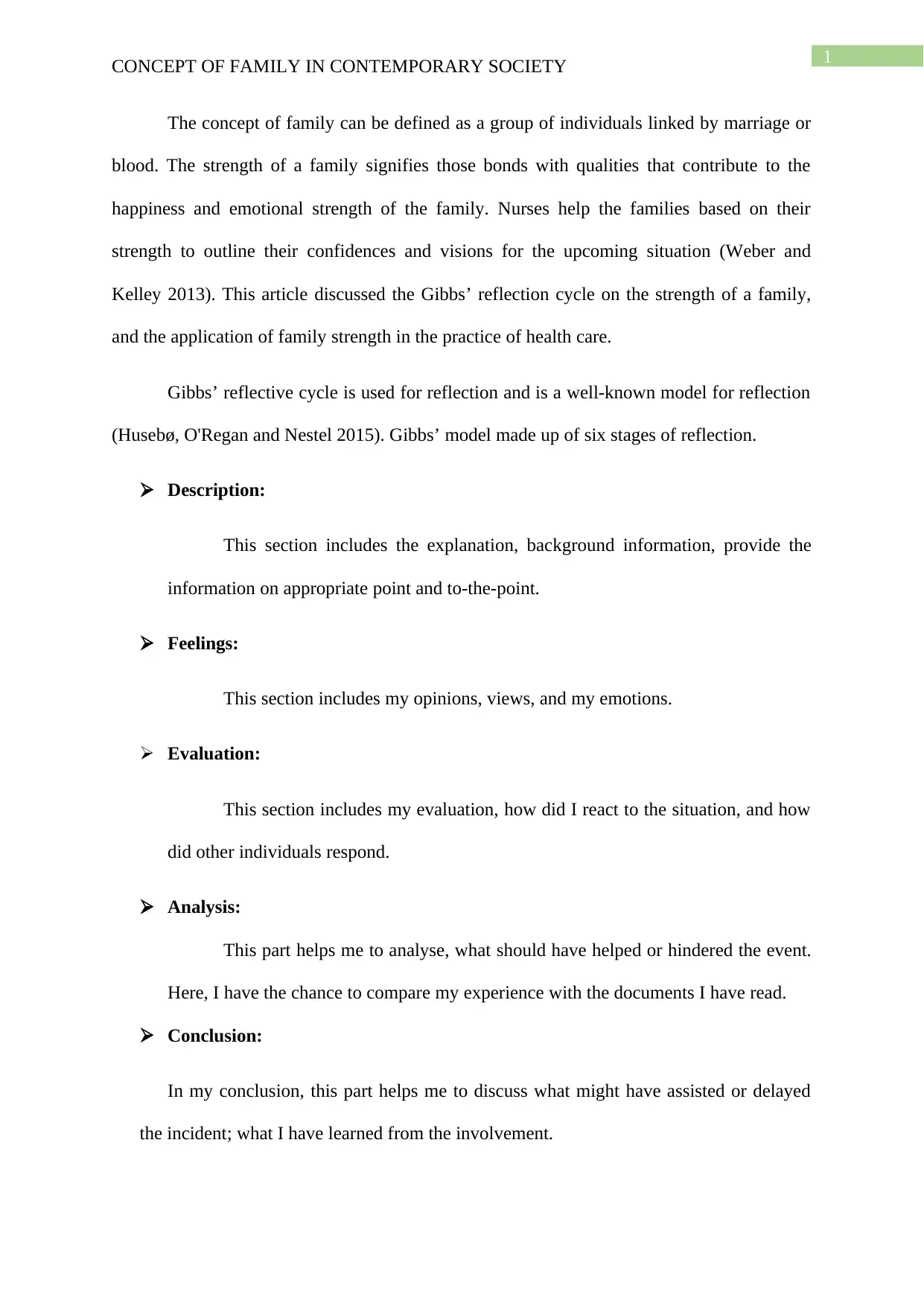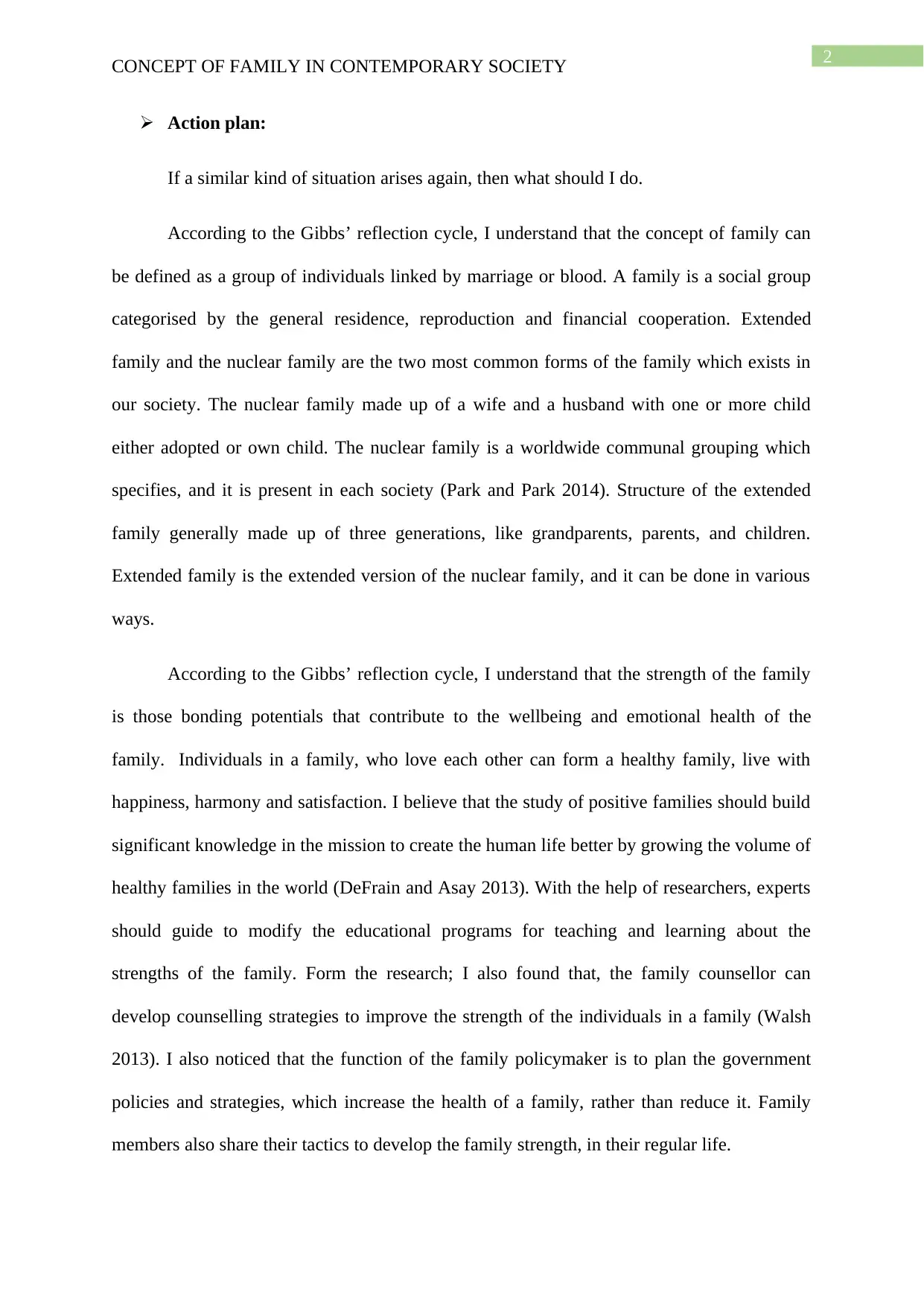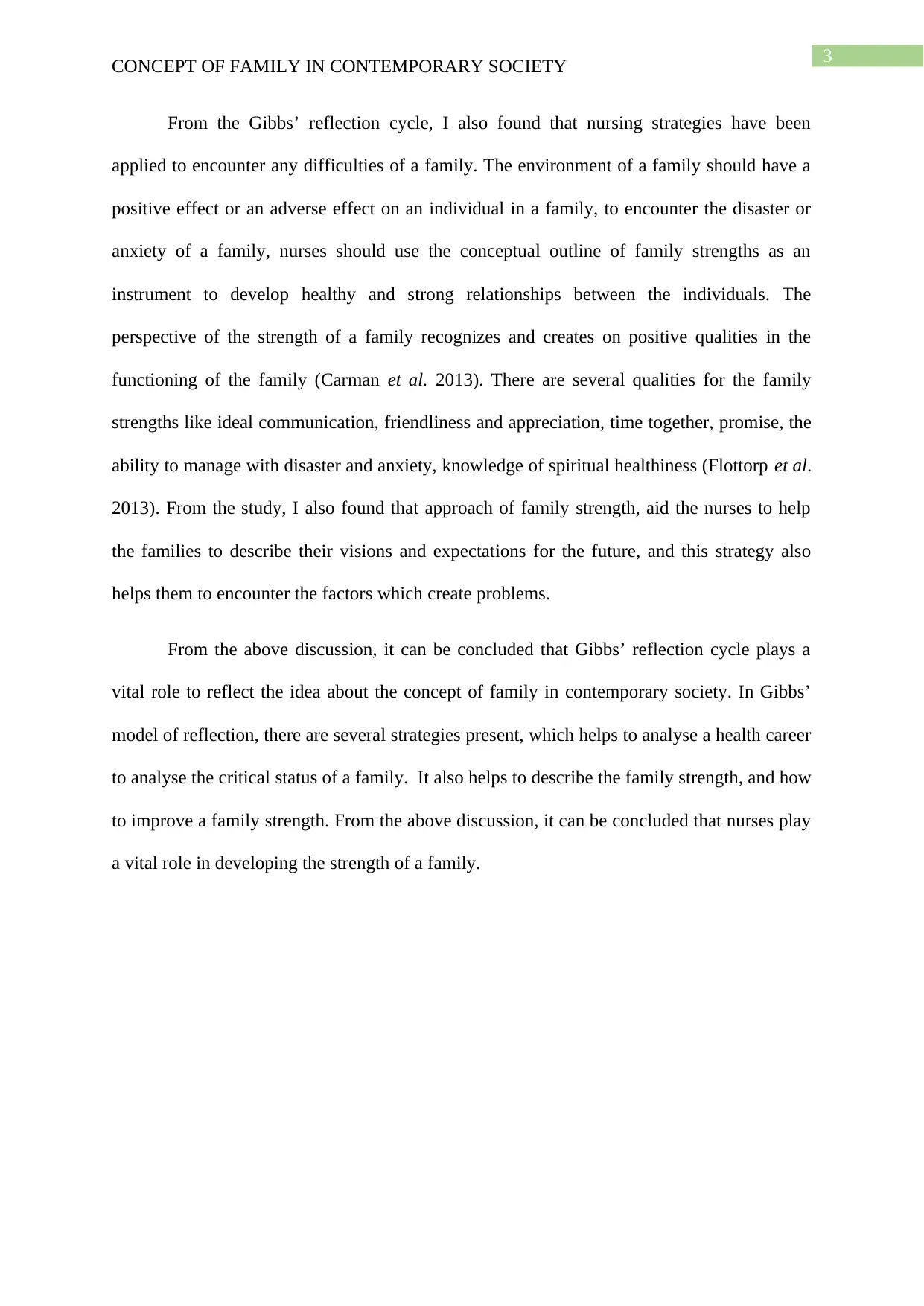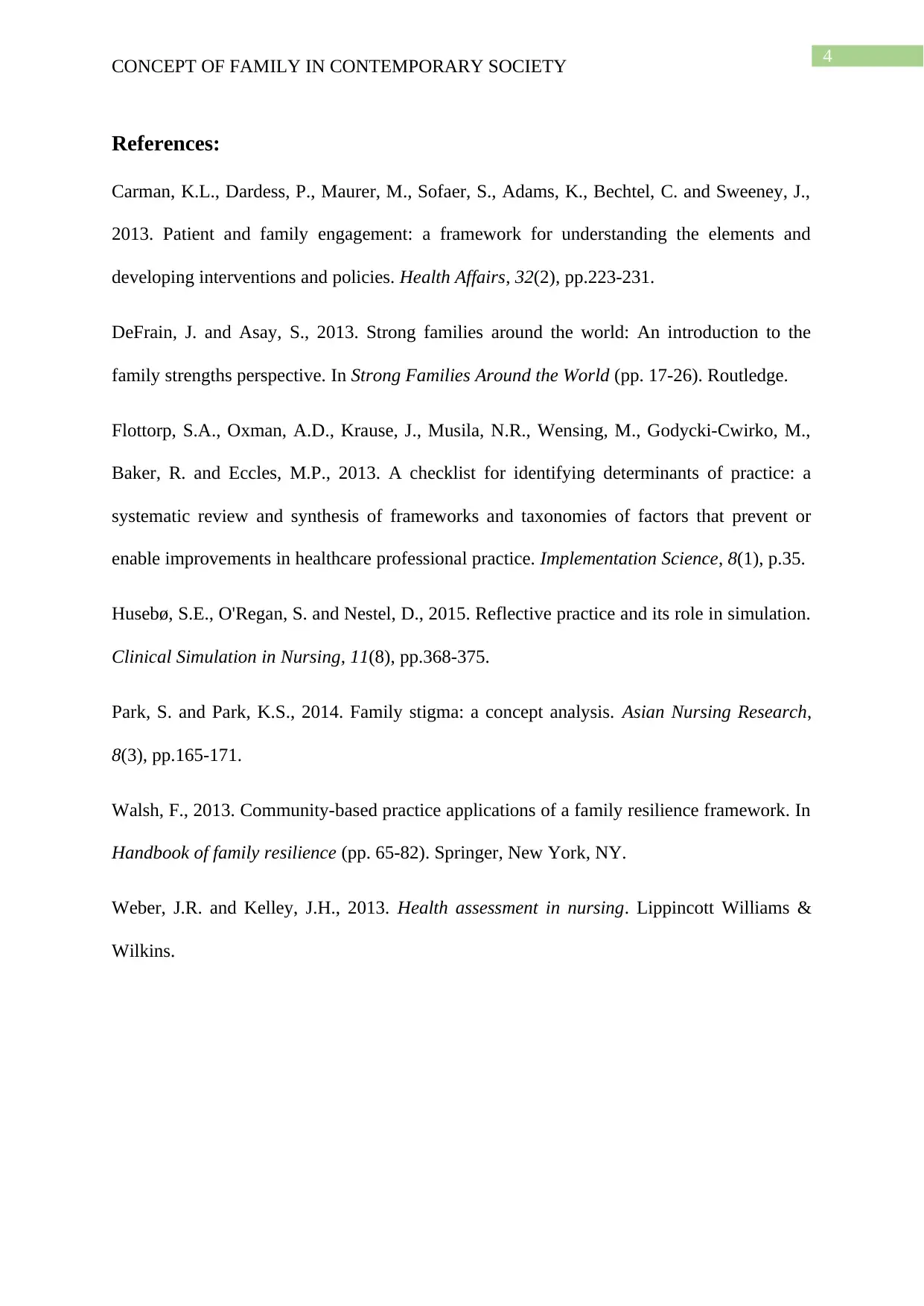Family Strengths in Contemporary Society: Gibbs' Reflective Cycle
VerifiedAdded on 2023/06/09
|5
|1254
|165
Essay
AI Summary
This essay reflects on the concept of family in contemporary society, defining it as a group linked by marriage or blood, and emphasizes the importance of family strengths for happiness and emotional well-being. It employs Gibbs’ reflective cycle (description, feelings, evaluation, analysis, conclusion, and action plan) to analyze family dynamics and the application of family strengths in healthcare practice. The essay differentiates between nuclear and extended families, highlighting the role of family counselors and policymakers in promoting family health. It also discusses how nurses can utilize the family strengths framework to address family challenges and foster positive relationships. Ultimately, the essay concludes that nurses play a vital role in developing family strength by understanding and addressing the factors that influence a family's ability to cope with disaster and anxiety, and by promoting effective communication, appreciation, and spiritual healthiness within the family unit. The essay also references scholarly articles and research to support the arguments and insights presented.

Running head: CONCEPT OF FAMILY IN CONTEMPORARY SOCIETY
Concept of family in contemporary society
Name of the student
Name of the university
Authors note
Concept of family in contemporary society
Name of the student
Name of the university
Authors note
Paraphrase This Document
Need a fresh take? Get an instant paraphrase of this document with our AI Paraphraser

1
CONCEPT OF FAMILY IN CONTEMPORARY SOCIETY
The concept of family can be defined as a group of individuals linked by marriage or
blood. The strength of a family signifies those bonds with qualities that contribute to the
happiness and emotional strength of the family. Nurses help the families based on their
strength to outline their confidences and visions for the upcoming situation (Weber and
Kelley 2013). This article discussed the Gibbs’ reflection cycle on the strength of a family,
and the application of family strength in the practice of health care.
Gibbs’ reflective cycle is used for reflection and is a well-known model for reflection
(Husebø, O'Regan and Nestel 2015). Gibbs’ model made up of six stages of reflection.
Description:
This section includes the explanation, background information, provide the
information on appropriate point and to-the-point.
Feelings:
This section includes my opinions, views, and my emotions.
Evaluation:
This section includes my evaluation, how did I react to the situation, and how
did other individuals respond.
Analysis:
This part helps me to analyse, what should have helped or hindered the event.
Here, I have the chance to compare my experience with the documents I have read.
Conclusion:
In my conclusion, this part helps me to discuss what might have assisted or delayed
the incident; what I have learned from the involvement.
CONCEPT OF FAMILY IN CONTEMPORARY SOCIETY
The concept of family can be defined as a group of individuals linked by marriage or
blood. The strength of a family signifies those bonds with qualities that contribute to the
happiness and emotional strength of the family. Nurses help the families based on their
strength to outline their confidences and visions for the upcoming situation (Weber and
Kelley 2013). This article discussed the Gibbs’ reflection cycle on the strength of a family,
and the application of family strength in the practice of health care.
Gibbs’ reflective cycle is used for reflection and is a well-known model for reflection
(Husebø, O'Regan and Nestel 2015). Gibbs’ model made up of six stages of reflection.
Description:
This section includes the explanation, background information, provide the
information on appropriate point and to-the-point.
Feelings:
This section includes my opinions, views, and my emotions.
Evaluation:
This section includes my evaluation, how did I react to the situation, and how
did other individuals respond.
Analysis:
This part helps me to analyse, what should have helped or hindered the event.
Here, I have the chance to compare my experience with the documents I have read.
Conclusion:
In my conclusion, this part helps me to discuss what might have assisted or delayed
the incident; what I have learned from the involvement.

2
CONCEPT OF FAMILY IN CONTEMPORARY SOCIETY
Action plan:
If a similar kind of situation arises again, then what should I do.
According to the Gibbs’ reflection cycle, I understand that the concept of family can
be defined as a group of individuals linked by marriage or blood. A family is a social group
categorised by the general residence, reproduction and financial cooperation. Extended
family and the nuclear family are the two most common forms of the family which exists in
our society. The nuclear family made up of a wife and a husband with one or more child
either adopted or own child. The nuclear family is a worldwide communal grouping which
specifies, and it is present in each society (Park and Park 2014). Structure of the extended
family generally made up of three generations, like grandparents, parents, and children.
Extended family is the extended version of the nuclear family, and it can be done in various
ways.
According to the Gibbs’ reflection cycle, I understand that the strength of the family
is those bonding potentials that contribute to the wellbeing and emotional health of the
family. Individuals in a family, who love each other can form a healthy family, live with
happiness, harmony and satisfaction. I believe that the study of positive families should build
significant knowledge in the mission to create the human life better by growing the volume of
healthy families in the world (DeFrain and Asay 2013). With the help of researchers, experts
should guide to modify the educational programs for teaching and learning about the
strengths of the family. Form the research; I also found that, the family counsellor can
develop counselling strategies to improve the strength of the individuals in a family (Walsh
2013). I also noticed that the function of the family policymaker is to plan the government
policies and strategies, which increase the health of a family, rather than reduce it. Family
members also share their tactics to develop the family strength, in their regular life.
CONCEPT OF FAMILY IN CONTEMPORARY SOCIETY
Action plan:
If a similar kind of situation arises again, then what should I do.
According to the Gibbs’ reflection cycle, I understand that the concept of family can
be defined as a group of individuals linked by marriage or blood. A family is a social group
categorised by the general residence, reproduction and financial cooperation. Extended
family and the nuclear family are the two most common forms of the family which exists in
our society. The nuclear family made up of a wife and a husband with one or more child
either adopted or own child. The nuclear family is a worldwide communal grouping which
specifies, and it is present in each society (Park and Park 2014). Structure of the extended
family generally made up of three generations, like grandparents, parents, and children.
Extended family is the extended version of the nuclear family, and it can be done in various
ways.
According to the Gibbs’ reflection cycle, I understand that the strength of the family
is those bonding potentials that contribute to the wellbeing and emotional health of the
family. Individuals in a family, who love each other can form a healthy family, live with
happiness, harmony and satisfaction. I believe that the study of positive families should build
significant knowledge in the mission to create the human life better by growing the volume of
healthy families in the world (DeFrain and Asay 2013). With the help of researchers, experts
should guide to modify the educational programs for teaching and learning about the
strengths of the family. Form the research; I also found that, the family counsellor can
develop counselling strategies to improve the strength of the individuals in a family (Walsh
2013). I also noticed that the function of the family policymaker is to plan the government
policies and strategies, which increase the health of a family, rather than reduce it. Family
members also share their tactics to develop the family strength, in their regular life.
⊘ This is a preview!⊘
Do you want full access?
Subscribe today to unlock all pages.

Trusted by 1+ million students worldwide

3
CONCEPT OF FAMILY IN CONTEMPORARY SOCIETY
From the Gibbs’ reflection cycle, I also found that nursing strategies have been
applied to encounter any difficulties of a family. The environment of a family should have a
positive effect or an adverse effect on an individual in a family, to encounter the disaster or
anxiety of a family, nurses should use the conceptual outline of family strengths as an
instrument to develop healthy and strong relationships between the individuals. The
perspective of the strength of a family recognizes and creates on positive qualities in the
functioning of the family (Carman et al. 2013). There are several qualities for the family
strengths like ideal communication, friendliness and appreciation, time together, promise, the
ability to manage with disaster and anxiety, knowledge of spiritual healthiness (Flottorp et al.
2013). From the study, I also found that approach of family strength, aid the nurses to help
the families to describe their visions and expectations for the future, and this strategy also
helps them to encounter the factors which create problems.
From the above discussion, it can be concluded that Gibbs’ reflection cycle plays a
vital role to reflect the idea about the concept of family in contemporary society. In Gibbs’
model of reflection, there are several strategies present, which helps to analyse a health career
to analyse the critical status of a family. It also helps to describe the family strength, and how
to improve a family strength. From the above discussion, it can be concluded that nurses play
a vital role in developing the strength of a family.
CONCEPT OF FAMILY IN CONTEMPORARY SOCIETY
From the Gibbs’ reflection cycle, I also found that nursing strategies have been
applied to encounter any difficulties of a family. The environment of a family should have a
positive effect or an adverse effect on an individual in a family, to encounter the disaster or
anxiety of a family, nurses should use the conceptual outline of family strengths as an
instrument to develop healthy and strong relationships between the individuals. The
perspective of the strength of a family recognizes and creates on positive qualities in the
functioning of the family (Carman et al. 2013). There are several qualities for the family
strengths like ideal communication, friendliness and appreciation, time together, promise, the
ability to manage with disaster and anxiety, knowledge of spiritual healthiness (Flottorp et al.
2013). From the study, I also found that approach of family strength, aid the nurses to help
the families to describe their visions and expectations for the future, and this strategy also
helps them to encounter the factors which create problems.
From the above discussion, it can be concluded that Gibbs’ reflection cycle plays a
vital role to reflect the idea about the concept of family in contemporary society. In Gibbs’
model of reflection, there are several strategies present, which helps to analyse a health career
to analyse the critical status of a family. It also helps to describe the family strength, and how
to improve a family strength. From the above discussion, it can be concluded that nurses play
a vital role in developing the strength of a family.
Paraphrase This Document
Need a fresh take? Get an instant paraphrase of this document with our AI Paraphraser

4
CONCEPT OF FAMILY IN CONTEMPORARY SOCIETY
References:
Carman, K.L., Dardess, P., Maurer, M., Sofaer, S., Adams, K., Bechtel, C. and Sweeney, J.,
2013. Patient and family engagement: a framework for understanding the elements and
developing interventions and policies. Health Affairs, 32(2), pp.223-231.
DeFrain, J. and Asay, S., 2013. Strong families around the world: An introduction to the
family strengths perspective. In Strong Families Around the World (pp. 17-26). Routledge.
Flottorp, S.A., Oxman, A.D., Krause, J., Musila, N.R., Wensing, M., Godycki-Cwirko, M.,
Baker, R. and Eccles, M.P., 2013. A checklist for identifying determinants of practice: a
systematic review and synthesis of frameworks and taxonomies of factors that prevent or
enable improvements in healthcare professional practice. Implementation Science, 8(1), p.35.
Husebø, S.E., O'Regan, S. and Nestel, D., 2015. Reflective practice and its role in simulation.
Clinical Simulation in Nursing, 11(8), pp.368-375.
Park, S. and Park, K.S., 2014. Family stigma: a concept analysis. Asian Nursing Research,
8(3), pp.165-171.
Walsh, F., 2013. Community-based practice applications of a family resilience framework. In
Handbook of family resilience (pp. 65-82). Springer, New York, NY.
Weber, J.R. and Kelley, J.H., 2013. Health assessment in nursing. Lippincott Williams &
Wilkins.
CONCEPT OF FAMILY IN CONTEMPORARY SOCIETY
References:
Carman, K.L., Dardess, P., Maurer, M., Sofaer, S., Adams, K., Bechtel, C. and Sweeney, J.,
2013. Patient and family engagement: a framework for understanding the elements and
developing interventions and policies. Health Affairs, 32(2), pp.223-231.
DeFrain, J. and Asay, S., 2013. Strong families around the world: An introduction to the
family strengths perspective. In Strong Families Around the World (pp. 17-26). Routledge.
Flottorp, S.A., Oxman, A.D., Krause, J., Musila, N.R., Wensing, M., Godycki-Cwirko, M.,
Baker, R. and Eccles, M.P., 2013. A checklist for identifying determinants of practice: a
systematic review and synthesis of frameworks and taxonomies of factors that prevent or
enable improvements in healthcare professional practice. Implementation Science, 8(1), p.35.
Husebø, S.E., O'Regan, S. and Nestel, D., 2015. Reflective practice and its role in simulation.
Clinical Simulation in Nursing, 11(8), pp.368-375.
Park, S. and Park, K.S., 2014. Family stigma: a concept analysis. Asian Nursing Research,
8(3), pp.165-171.
Walsh, F., 2013. Community-based practice applications of a family resilience framework. In
Handbook of family resilience (pp. 65-82). Springer, New York, NY.
Weber, J.R. and Kelley, J.H., 2013. Health assessment in nursing. Lippincott Williams &
Wilkins.
1 out of 5
Related Documents
Your All-in-One AI-Powered Toolkit for Academic Success.
+13062052269
info@desklib.com
Available 24*7 on WhatsApp / Email
![[object Object]](/_next/static/media/star-bottom.7253800d.svg)
Unlock your academic potential
Copyright © 2020–2025 A2Z Services. All Rights Reserved. Developed and managed by ZUCOL.





